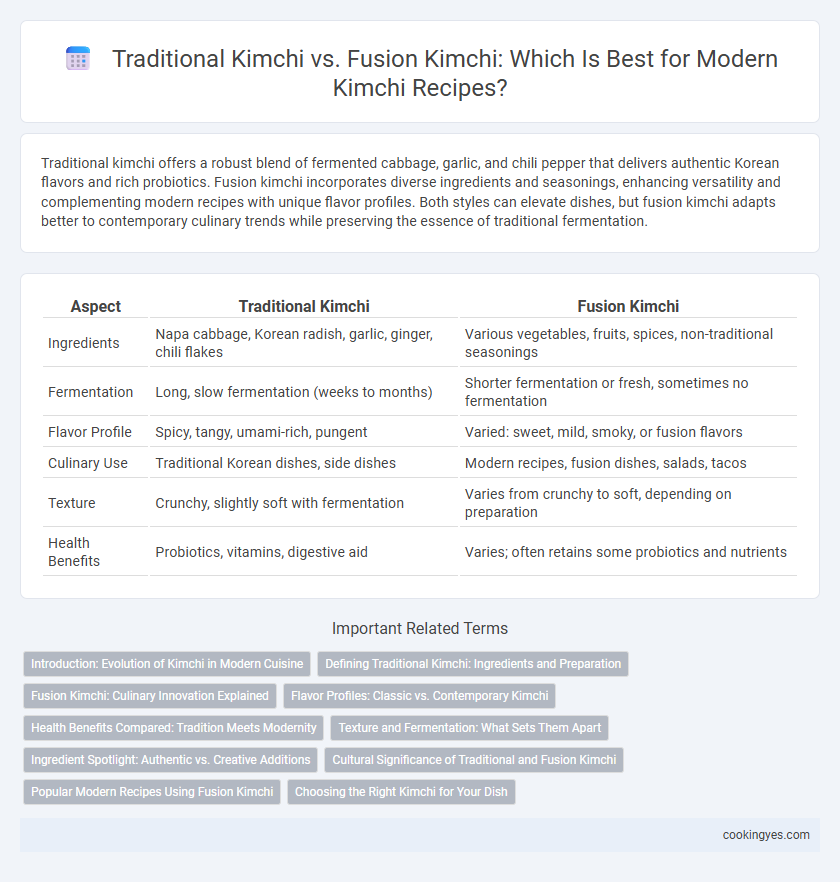Traditional kimchi offers a robust blend of fermented cabbage, garlic, and chili pepper that delivers authentic Korean flavors and rich probiotics. Fusion kimchi incorporates diverse ingredients and seasonings, enhancing versatility and complementing modern recipes with unique flavor profiles. Both styles can elevate dishes, but fusion kimchi adapts better to contemporary culinary trends while preserving the essence of traditional fermentation.
Table of Comparison
| Aspect | Traditional Kimchi | Fusion Kimchi |
|---|---|---|
| Ingredients | Napa cabbage, Korean radish, garlic, ginger, chili flakes | Various vegetables, fruits, spices, non-traditional seasonings |
| Fermentation | Long, slow fermentation (weeks to months) | Shorter fermentation or fresh, sometimes no fermentation |
| Flavor Profile | Spicy, tangy, umami-rich, pungent | Varied: sweet, mild, smoky, or fusion flavors |
| Culinary Use | Traditional Korean dishes, side dishes | Modern recipes, fusion dishes, salads, tacos |
| Texture | Crunchy, slightly soft with fermentation | Varies from crunchy to soft, depending on preparation |
| Health Benefits | Probiotics, vitamins, digestive aid | Varies; often retains some probiotics and nutrients |
Introduction: Evolution of Kimchi in Modern Cuisine
Traditional kimchi, rooted in centuries-old Korean fermentation practices, emphasizes preserved napa cabbage and radish with chili flakes, garlic, and salted seafood, delivering authentic umami and probiotic benefits. Fusion kimchi experiments with diverse ingredients such as fruits, cheese, or non-traditional vegetables, adapting its flavor profile to global culinary trends and enhancing versatility in modern recipes. This evolution reflects kimchi's dynamic role in contemporary cuisine, blending heritage with innovation to cater to varied palates and health-conscious consumers.
Defining Traditional Kimchi: Ingredients and Preparation
Traditional kimchi features fermented Napa cabbage, radishes, garlic, ginger, Korean red chili pepper flakes (gochugaru), and fish sauce, prepared through a meticulous salting and fermentation process lasting several weeks. Classic recipes emphasize natural fermentation in earthenware pots (onggi), preserving authentic probiotic qualities and rich umami flavors. These foundational techniques establish the characteristic tangy, spicy profile that defines traditional Korean kimchi.
Fusion Kimchi: Culinary Innovation Explained
Fusion kimchi incorporates diverse ingredients and global flavors, transforming traditional Korean fermentation into inventive culinary experiences. Chefs innovate with additions like tropical fruits, exotic spices, and unconventional vegetables, enhancing taste profiles and broadening appeal. This evolution reflects cultural exchange and modern gastronomy trends, positioning fusion kimchi as a versatile ingredient in contemporary recipes.
Flavor Profiles: Classic vs. Contemporary Kimchi
Traditional kimchi features a robust, fermented flavor profile that balances tangy, spicy, and umami notes, developed through a careful aging process using napa cabbage, garlic, ginger, and Korean chili flakes. Fusion kimchi introduces contemporary twists by incorporating diverse ingredients like fruits, non-traditional vegetables, or alternative spices, resulting in a milder, sweeter, or more complex flavor suitable for creative modern recipes. The contrast between classic and fusion kimchi lies in their depth of fermentation and ingredient versatility, influencing their application in traditional dishes versus innovative culinary creations.
Health Benefits Compared: Tradition Meets Modernity
Traditional kimchi, rich in probiotics and vitamins from natural fermentation, offers potent digestive and immune system support. Fusion kimchi incorporates diverse ingredients and spices, enhancing antioxidant properties and introducing new flavors while maintaining essential health benefits. Both versions contribute to gut health and overall wellness, with traditional kimchi emphasizing time-tested fermentation methods and fusion kimchi adapting to contemporary dietary preferences.
Texture and Fermentation: What Sets Them Apart
Traditional kimchi features a robust fermentation process that develops complex, tangy flavors and a firm, crunchy texture through natural lactic acid bacteria. Fusion kimchi often incorporates unique ingredients and shorter fermentation times, resulting in milder flavors and varied textures ranging from crisp to soft. The difference in fermentation duration and ingredient composition directly influences the texture and taste profile, making traditional kimchi more pungent and crunchy, while fusion variants offer versatility suited for modern culinary applications.
Ingredient Spotlight: Authentic vs. Creative Additions
Traditional kimchi highlights Napa cabbage, Korean radish, garlic, ginger, and red chili pepper flakes as core ingredients, preserving authentic flavors rooted in centuries-old fermentation techniques. Fusion kimchi introduces creative additions such as mango, cheese, or even bacon, offering unique twists that appeal to contemporary palates and modern culinary experimentation. Emphasizing ingredient quality and balance, both versions maintain nutritional benefits while catering to varying taste preferences in evolving recipes.
Cultural Significance of Traditional and Fusion Kimchi
Traditional kimchi embodies centuries of Korean heritage, preserving ancient fermentation techniques and authentic ingredients that symbolize cultural identity and community values. Fusion kimchi integrates diverse flavors and modern ingredients, reflecting globalization's impact and evolving culinary creativity while maintaining the essence of its Korean roots. Both traditional and fusion kimchi highlight dynamic cultural significance by balancing preservation with innovation in contemporary cuisine.
Popular Modern Recipes Using Fusion Kimchi
Fusion kimchi incorporates diverse ingredients such as cheese, avocado, or fruit, enhancing its versatility in modern recipes like kimchi grilled cheese and kimchi tacos. Popular modern dishes using fusion kimchi include kimchi fried rice bowls, kimchi quesadillas, and kimchi burgers, which meld traditional Korean flavors with contemporary culinary trends. These innovative recipes highlight fusion kimchi's ability to complement both Western and Asian-inspired dishes while maintaining its signature spicy, tangy profile.
Choosing the Right Kimchi for Your Dish
Traditional kimchi, rich in fermented napa cabbage, Korean chili flakes, and garlic, offers an authentic tangy and spicy flavor ideal for classic dishes like kimchi jjigae and bibimbap. Fusion kimchi, often incorporating diverse ingredients such as fruits, cheeses, or non-traditional vegetables, provides a milder, innovative taste suited to modern recipes like kimchi tacos or salads. Selecting the right kimchi depends on the dish's flavor profile; robust traditional kimchi enhances hearty, spicy meals, while fusion varieties complement lighter or experimental culinary creations.
Traditional Kimchi vs Fusion Kimchi for modern recipes Infographic

 cookingyes.com
cookingyes.com